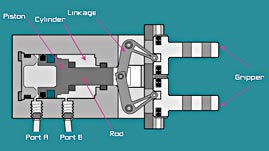Teachers' Domain - Digital Media for the Classroom and Professional Development
User: Preview

Source: MATEC
In this interactive activity adapted from MATEC, learn about pneumatic actuator systems, which use compressed air to transmit motion. Animations illustrate the components of a typical pneumatic actuator system: the computer, communication module, programmable logic controller, input/output module, solenoid valve, and pneumatic device. Observe how the system functions as a whole, and learn more about some common pneumatic devices.
Imagine a company that produces bottled tomato sauce. This company manufactures tens of millions of bottles of sauce every year. The sauce may taste like homemade, but in order to supply it in such large quantities, the company relies on automated systems to help with food processing and packaging. From measuring ingredients, to managing cooking temperature and time, to filling bottles and securing lids, to pasting labels, automated systems are used all along the process line.
Pneumatic systems, which use compressed air to do work, are a common type of automated system found on manufacturing lines. A basic pneumatic system consists of a piston, a cylinder, and valves. A manual bicycle pump illustrates how such a system works: when you pull up on the handle of the pump, a piston pulls air through a valve into the cylinder. When you push down on the handle of the pump, that valve closes and the air inside the cylinder gets compressed. The compressed air is forced through another valve into a hose that leads to the tire tube. This cycle is repeated until the desired tire pressure is reached.
When compressed air moves from one location to another, it transfers energy. The energy of compressed air can be used to actuate devices, to move things, or to perform a particular action. Pneumatic systems control the air handling systems that control the heating and cooling of air in buildings, they are used to push the tubes back and forth at drive-up bank tellers, and they can even be used to mimic the motion of a human hand to pick up and place objects.
Another common type of automated system—a hydraulic system—operates similarly to a pneumatic system, but uses a noncompressible fluid, such as water or oil, instead of compressed air. Energy is transferred as the fluid is redirected throughout the machinery. Because of the noncompressibility of the fluid, hydraulic systems can withstand very high pressures and are used for loads that are too heavy for pneumatic systems to handle. Pneumatic and hydraulic actuator systems have diverse applications and are used in nearly every piece of equipment in an automated manufacturing line.
Automated systems are useful for a variety of reasons. First, they can perform repetitive operations that a human worker would find very boring and fatiguing. Second, they can increase productivity by performing operations more quickly than a human can. Third, they are more precise and therefore make products of consistently high quality. And finally, they can perform functions that are impossible or too dangerous for humans to do.
 Loading Standards
Loading Standards Teachers' Domain is proud to be a Pathways portal to the National Science Digital Library.
Teachers' Domain is proud to be a Pathways portal to the National Science Digital Library.
